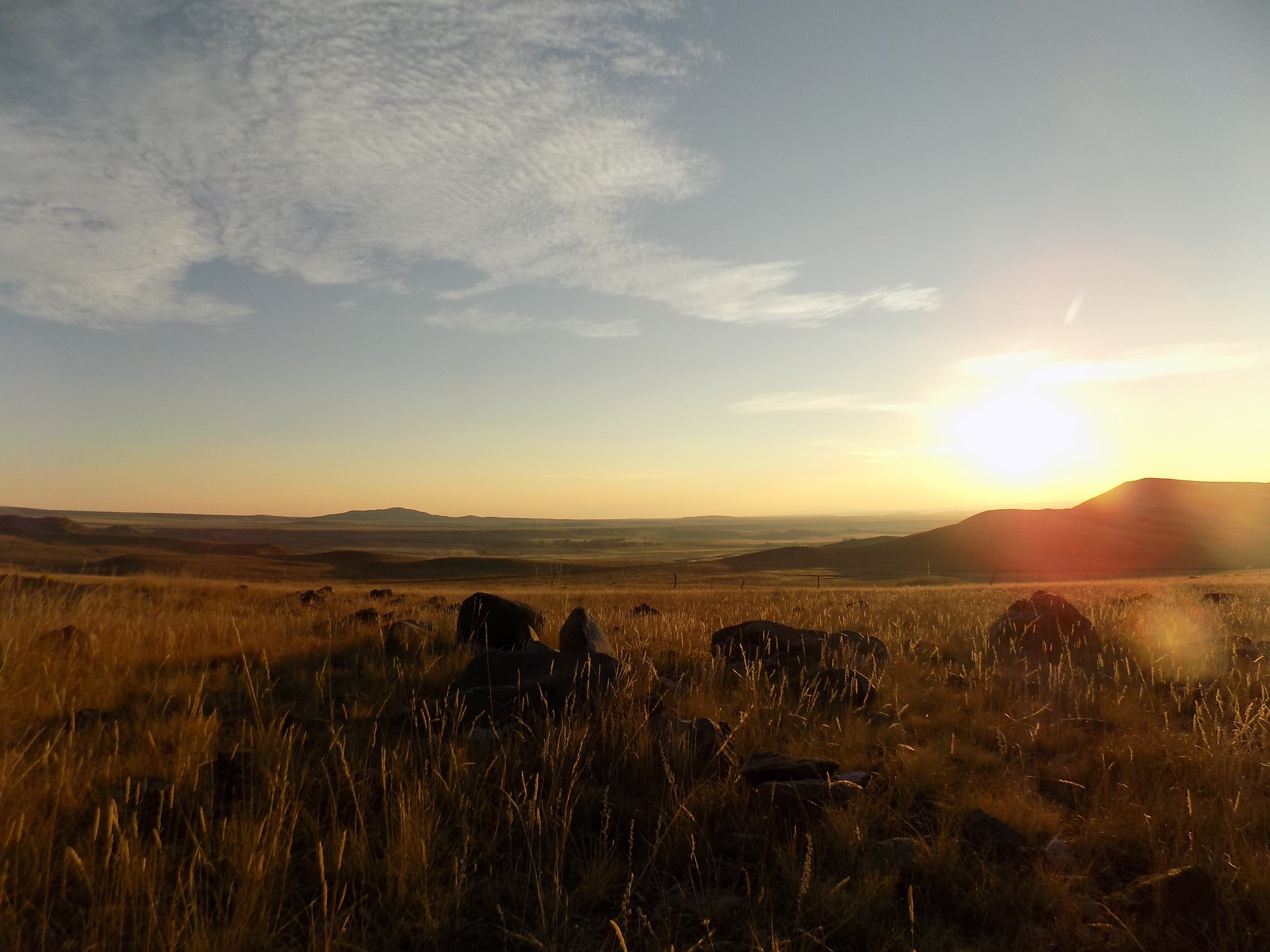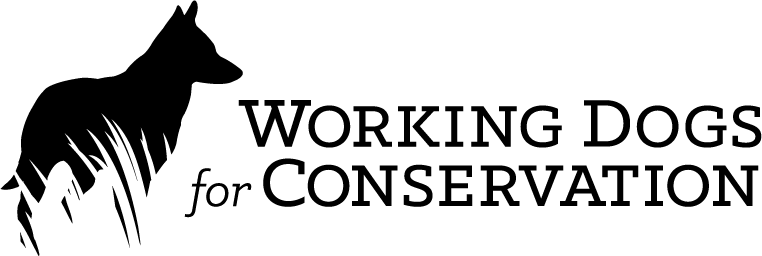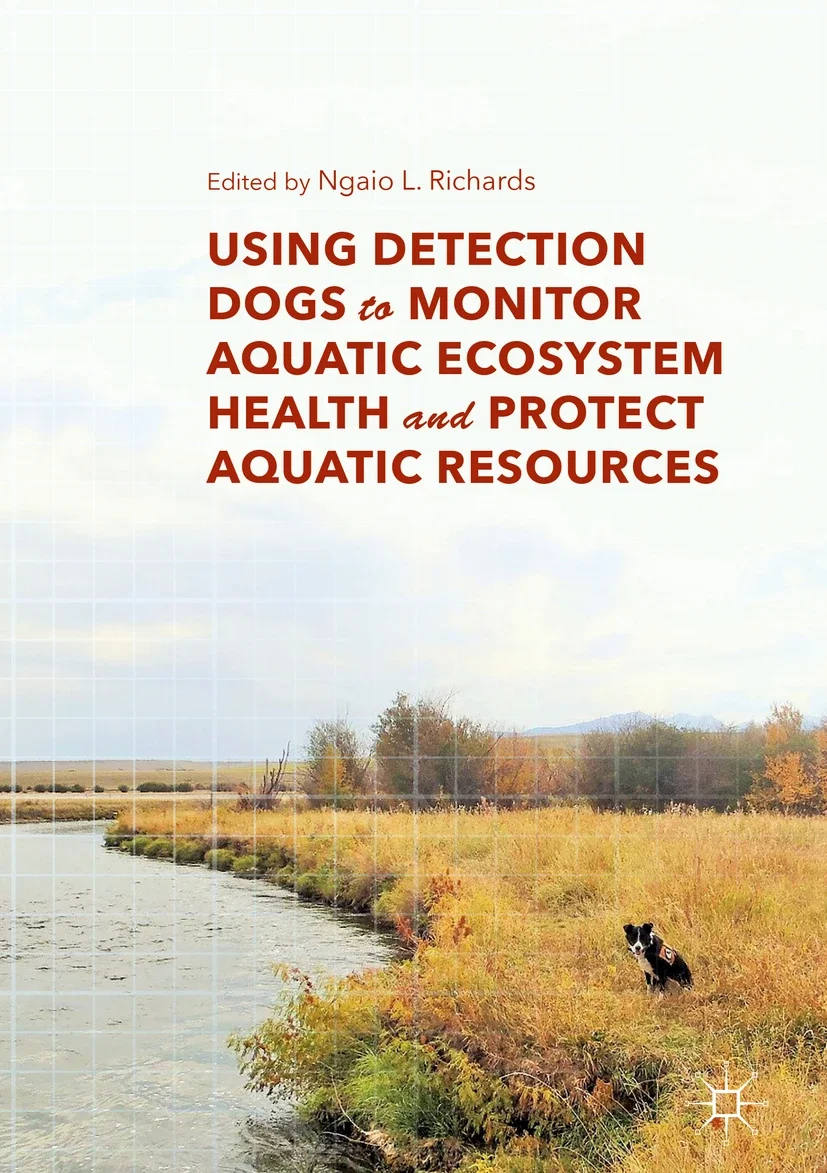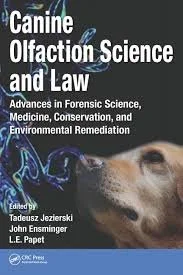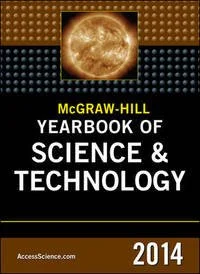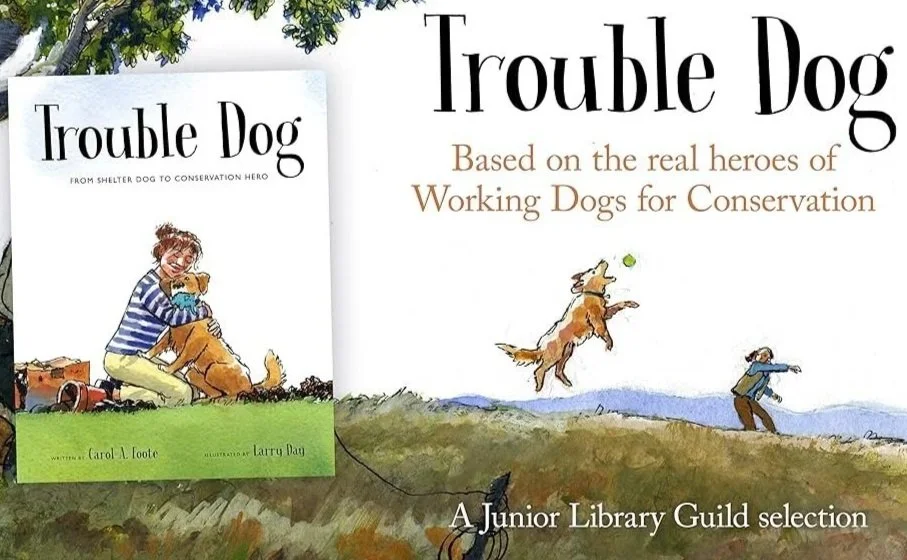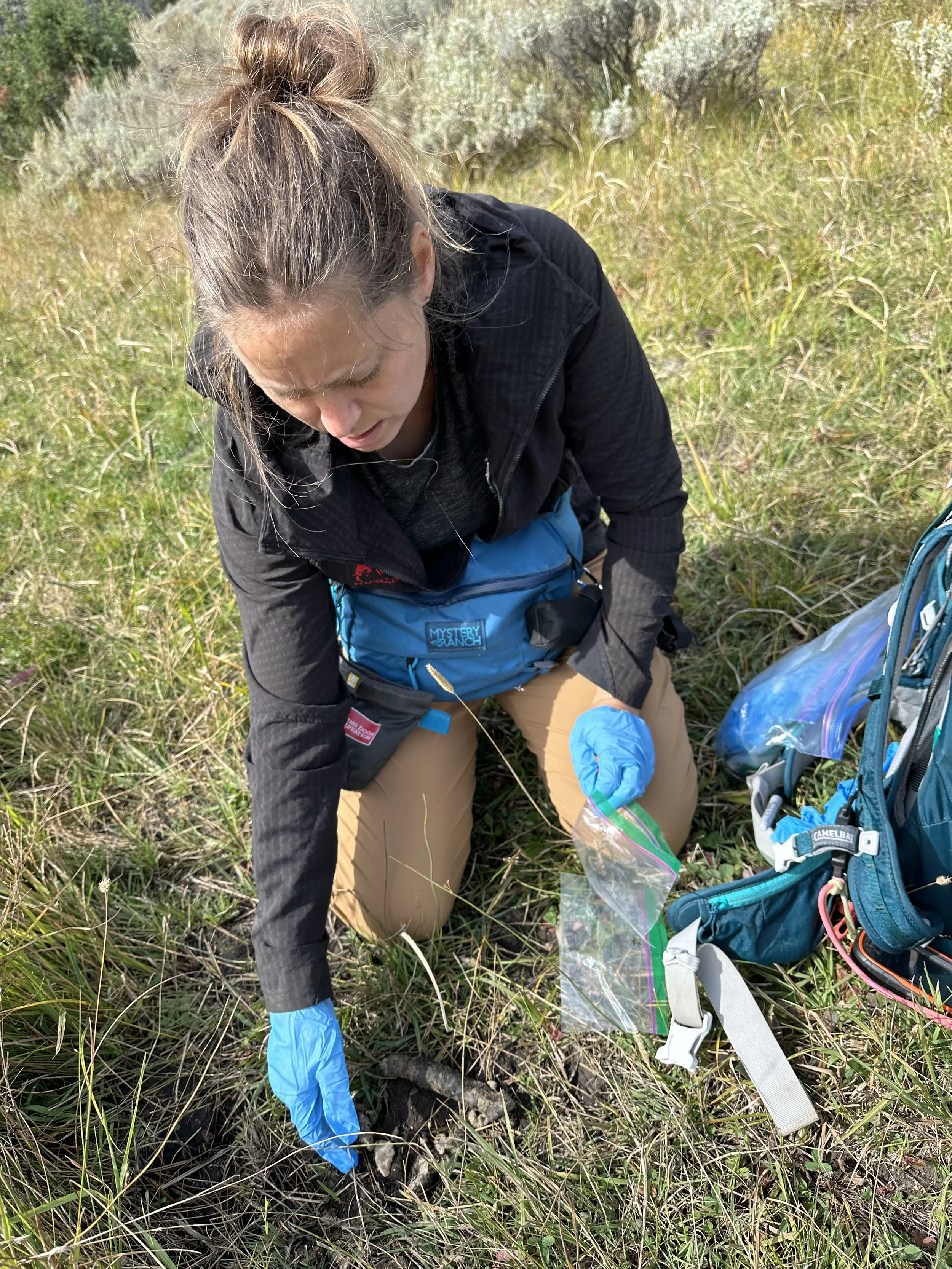
News and Publications
Books We’ve Contributed To
Children’s Books Recently Released
Two real canine heroes of Working Dogs for Conservation - legacy dogs Wicket and Pepin - were the inspiration for Tucker, the dog in this wonderful children’s book.
Written by WD4C friend and supporter, Carol A. Foote, and illustrated by Larry Day, Trouble Dog is the exciting story of an unwanted dog who found the perfect job and a loving home. Follow along with all of Tucker’s conservation adventures!
Visit the author’s website at www.carolafoote.com to learn more and order a copy. 50% of the author’s proceeds are donated to help support the dogs here at Working Dogs for Conservation!
Access the free education resource guide to accompany Trouble Dog HERE.
Working Dogs for Conservation staff and dogs are featured in one of the chapters in Detective Dogs: How Working Dogs Sniff out Invasive Species. Canine Field Specialists, Renae Counter and Michele Lovara, are featured with conservation canines, Frost and Fenton.
Written by Alison Pearce Stevens, with cover photography by Jeff Stevens.
Visit https://holidayhouse.com/book/detective-dogs/ for more information about this wonderful book.
Scientific Publications
-
Parasites & Vectors
Koser, T., Hurt, A., Thompson, L., Courtemanch, A., Wise, B., and Cross, P. (2025). Scent detection dogs detect a species of hard tick, Dermacentor albipictus, with comparable accuracy and efficiency to traditional tick drag surveys. Parasites & Vectors, 18 : 126-135.
Journal of Raptor Research
Buij, R., Richards, N.L., Rooney, E., Ruddock, M., Horváth, M., Krone, O., Mason, H., Shorrock, G., Chriél, M., Deák, G., Demerdzhiev, D., Deutschová, L., Doktorová, S., Inderwildi, E., Jaspers, V.L.B., Jenny, D., Mikuska, T., Miskovic, M., Mizera, T., Nagy, A., Ntemiri, K., O'Donoghue, B., Ružić, M., Saravia-Mullin, V., Stoychev, S., Tavares, J., Andevski, J., van Tulden, P., Velevski, M., Vermouzek, Z., Vrezec, A., Zorrilla, I., and McClure, C.J.W. (2025). Raptor poisoning in Europe between 1996 and 2016: A continental assessment of the most affected species and the most used poisons. 59(2):1-19.
-
Ecosphere
Fuller, A.K., Augustine, B.C., Clifton, E.H., Hajek, A.E., Blumenthal, A., Beese, J., Hurt, A., and Brown-Lima, C.J. (2024). Effectiveness of canine-assisted surveillance and human searches for early detection of invasive spotted lanternfly. 15(12): e70113.
Sandgrouse
Whitehouse-Tedd, K., Thomas, J., Duckenfield, M., Upton, S., Hall, S., Richards, N.L., Phipps, L., Whitehouse-Tedd, G., and Cale, H. (2024). First assessment of coprophagic feeding behaviour in captive Egyptian Vultures Neophron percnopterus and Hooded Vultures Necrosyrtes monachus: implications for wild vulture health in agricultural landscapes. 46: 30 - 52.
-
Journal of Veterinary Forensic Sciences
Fernández., R.A., Piedrola Negreira, Ó., Cabañés Rodríguez,D., Ramírez Rodríguez, S., Montes Martín, J., Pérez Fuentes, A.A., Blázquez Ranquel, J.A., Briones Dieste, V., Richards, N.L., and Bárcena Asensio, C. (2023). Is Bradykinin 1-5 a reliable biomarker for pain in dogs? 2(1).
-
Vulture News
Buij, R., McClure, C.J.W., Hassell, J.M., Awoyemi, S., Richards, N.L., Virani, M.Z., and Ottinger, M.A. (2022). Exposure to zoonoses and pesticides during procurement, trade and consumption of vulture parts: an unexplored threat to human health. 81: 25 - 33.
-
(also see our co-authored chapter above in Books section)
PLOSONE
Liczner, A.R., MacPhail, V.J., (Smith) Woollett, D.A. Richards, N.L., and Colla, S.R. (2021). Training and usage of detection dogs to better understand bumble bee nesting habitat: Challenges and opportunities. 16(5): e0249248.
&
Liczner, A.R., MacPhail, V.J., (Smith) Woollett, D.A. Richards, N.L., and Colla, S.R. (2021). Training and usage of detection dogs to better understand bumble bee nesting habitat: Challenges and opportunities. S1 Appendix: Additional considerations for using detection dogs to find bumble bee nests and in related conservation efforts. 16(5): e0249248.
Journal of Insect Conservation
Verón, I.F., Zorrilla, I., and Richards, N.L. (2021). Is deliberate pesticide poisoning of wildlife impacting local insect communities? Wildlife and environmental forensic investigations in southern Spain present an opportunity for collaborative entomological monitoring. 25:511-519.
-
Chemosphere
LaGuardia, M.J., Richards, N.L., and Hale, R.C. (2020). A noninvasive environmental monitoring tool for brominated flame-retardants (BFRs) assisted by conservation detection dogs. 260: 127401 [Part of Special Issue: The 9th International Symposium on Flame Retardants, Montréal, Québec – 2019].
Journal of Vertebrate Biology
Whitehouse-Tedd, K., Richards, N., and Parker, M. (2020). Dogs and Conservation: emerging themes and considerations. 69(3): E2004. Guest Editors of the Special Issue: Dogs and Conservation: emerging themes and considerations.
Journal of Wildlife Management
Statham, M.J., Woollett (Smith), D.A., Fresquez, S., Pfeiffer, J., Richmond, J., Whitelaw, A., Richards, N.L., Westphal, M.F., and Sacks, B.N. (2020). Noninvasive identification of herpetofauna: Pairing conservation dogs and genetic analysis. 84(1): 66-74.
Journal of Veterinary Forensic Science
Wells, K., Butterworth, A., and Richards, N.L. (2020). A review of secondary pentobarbital poisoning in scavenging wildlife, companion animals and captive carnivores. 1(1): 1-15.
-
Conservation Genetics
Wilbert, T.R., Woollett (Smith), D.A., Westphal, M.F., Whitelaw, A., Ralls, K., and Maldonado, J.E. (2019). Distribution, fine-scale subdivision, and population size of San Joaquin kit foxes in the Ciervo-Panoche Natural Area, California. 20: 405-417.
Wildlife Research Monographs
Ogada, D., Richards N.L., and Behmke, S. (2019). What makes carrion unsafe for scavengers? Considerations for appropriate regulatory policies and sound management practices. In: Olea, P., Mateo-Tomás P., and Sánchez-Zapata, J. (eds), Carrion Ecology and Management. Springer, Switzerland, Volume 2: 213 - 240.
-
(also see our co-authored chapter and edited textbook above in Books section)
Journal of Wildlife Rehabilitation
Zorrilla, I., Richards, N.L., Benítez, J.R., Calvino, M., Fernandez, I., and Rodriguez, F. (2018). Case study: detection of two nonsteroidal anti-inflammatory drugs (NSAIDs) in the eggs of captive-reared bearded vultures at a breeding center in southern Spain. 38: 15-27.
-
Encyclopedia of the Anthropocene
Richards, N.L., Ogada, D., Buij, R., and Botha, A. (2017). The killing fields: The use of pesticides and other contaminants to poison wildlife in Africa. Volume 5: (Contaminants) 161-167.
Encyclopedia of the Anthropocene
Richards, N.L., Gilbert, M., Taggart, M., and Naidoo, V. (2017). A cautionary tale: Diclofenac and its profound impact on vultures. Volume 5: (Contaminants) 247-255.
Vulture News
Richards, N.L., Zorilla, I., Lalah, J., and Otieno, P. (2017). Talons and beaks are viable but underutilized samples in which to detect organophosphorus and carbamate pesticide poisoning in birds. 72: 3-13.
-
(also see our chapter authored above in Books section)
Alces: A Journal Devoted to the Biology and Management of Moose
Kretser, H., Glennon, M., Whitelaw, A., Hurt, A., Pilgrim, K., and Schwartz, M (2016). Scat-detection dogs survey low density moose in New York. 52: 55-66.
Proceedings of the 3rd Northern Rockies Invasive Plants Council Conference
Hurt, A., Guscio, D., Tirmenstein, D.A., Richards, N., Burch, A., and Marler, M. (2016). Using search dogs for biological eradication programs - A tale about dyer's woad (Isatis tinctoria L.), pp.73–86. In: Schwarzländer, M. and Gaskin, J.H. (eds). Airway Heights, WA. USDA Forest Service, Forest Health Technology Enterprise Team, Morgantown, West Virginia. FHTET-2016-03. 189 pp.
-
Royal Society Open Science
Arandjelovic, M., Bergl, R.A., Ikfuingei, R., Jameson, C., Parker, M., and L. Vigilant (2015) Detection dog efficacy for collecting faecal samples from the critically endangered Cross River gorilla (Gorilla gorilla diehli) for genetic censusing. 2: 140423.
Western North American Naturalist
Beckmann, J.P., Waits, L.P., Aimee Hurt, A., Whitelaw, A., and S. Bergen (2015). Using detection dogs and RSPF models to assess habitat suitability for bears in greater Yellowstone. 75(4):396-405.
Endangered Species Research
Wilbert, T. R., Woollett (Smith), D. A., Whitelaw, A., Dart, J., Hoyt, J. R., Galen, S., Ralls, K, Meade, D. E., and J.E . Maldonado (2015). Non-invasive baseline genetic monitoring of the endangered San Joaquin kit fox on a photovoltaic solar facility. 27: 31-41.
Royal Society of Chemistry
Taggart, M., Richards, N.L., and Kinney, C. (2015). Impacts of pharmaceuticals on terrestrial wildlife. In: Hester, R. (ed.), Pharmaceuticals in the Environment, (pp. 216-254). Issues in Environmental Science & Technology. Cambridge, United Kingdom, 294 pp.
Vulture News
Richards N.L., Zorrilla, I., Fernandez, I., Calvino, M., Garcia, J., and Ruiz, A. (2015). A preliminary assessment of the palate and tongue for detecting organophosphorus and carbamate pesticide exposure in the degraded carcasses of vultures and other animals. 68: 32-51.
-
(also see our authored and co-authored textbook chapters above in Books section)
Journal of Forensic Research
Richards, N.L., Hall, S.W., Harrison, N.M., Gautam, L., Scott, K.S., Dowling, G., Zorilla, I., and Fajardo, I. (2014). Merging wildlife and environmental monitoring approaches with forensic principles: application of unconventional and non-invasive sampling in eco-pharmacovigilance. 5:228.
Conservation Biology
Zorrilla, I., Taggart, M., Martinez, R., and Richards, N.L. (2014). Suspected flunixin poisoning of a wild Eurasian Griffon Vulture from Spain. 29(2): 587-592.
Philosophical Transactions of the Royal Society B
Shore, R.F., Taggart, M.A., Smits, J., Mateo, R., Richards, N.L., and Fryday, S. (2014). Detection and drivers of exposure and effects of pharmaceuticals in higher vertebrates. Special theme: ‘Assessing risks and impacts of pharmaceuticals in the environment on wildlife and ecosystems’. 369.
-
(see our edited textbook and co-authored chapter above in Books section)
-
Journal of Wildlife Management
Duggan, J.M., Heske, E.J., Schooley, R.L., Hurt, A., and Whitelaw, A. (2011). Comparing detection dog and livetrapping surveys for a cryptic rodent. 75: 1209-1217.
Journal of Wildlife Management
Reed, S.E., Bidlack, A.L., Hurt, A., and Getz, W.M. (2011). Detection distance and environmental factors in conservation detection dogs surveys. 75: 243-251.
-
Conservation Genetics Resources
Bozarth, C.A., Alva-Campbell, Y.R., Ralls, K., Henry, T.R., Smith, D.A., Westphal, M.F., and Maldonado, J.E.(2010). An efficient noninvasive method for discriminating among faeces of sympatric North American canids. 2: 173-175.
Journal of Wildlife Management
Ralls, K., Sharma, S., Smith, D.A., Bremner-Harrison, S., Cypher, B.L., and Maldonado, J.E. (2010). Changes in kit fox defecation patterns during the reproductive season: Implications for noninvasive surveys. 74: 1457-1462.
-
(see chapter author mention above in Books section)
-
(see our co-authored chapter in Books section above)
-
Southwestern Naturalist
Smith, D.A., Ralls, K., Cypher, B.L., Clark, Jr., H.O., Kelly, P.A., Williams, D.F., and Maldonado, J.E. (2006). Relative abundance of endangered San Joaquin kit foxes (Vulpes macrotis mutica) based on scat-detection dog surveys. 51: 210-219.
Wildlife Society Bulletin
Reindl-Thompson, S.A., Shivik, J.A., Whitelaw, A., Hurt, A., and Higgins, K. F. (2006). Efficacy of scent dogs in detecting black-footed ferrets at a reintroduction site in South Dakota. 34: 1435-1439.
Molecular Ecology
Smith, D. A., Ralls, K., Hurt, A., Adams, B., Parker, M., and Maldonado, J.E. (2006). Assessing reliability of microsatellite genotypes from kit fox fecal samples using genetic and GIS analyses. 15: 387-406.
-
Wildlife Society Bulletin
Smith, D.A., Ralls, K., Cypher, B.L., and Maldonado, J.E. (2005). Assessment of scat-detection dog surveys to determine kit fox distribution. 33: 897-904.
-
Western North American Naturalist
Ralls, K. and Smith, D. A. (2004). Latrine use by San Joaquin kit foxes (Vulpes macrotis mutica) and coyotes (Canis latrans). 64: 544-547.
-
Animal Conservation
Smith, D., Ralls, K., Hurt, A., Adams, B., Parker, M, Davenport, B., Smith, M.C., and Maldonado, J.E. (2003). Detection and accuracy rates of dogs trained to find scats of San Joaquin kit foxes (Vulpes macrotis mutica). 6:339–346.
-
Parker, M. 2001. Non-lethal management and compensation programs for predators. Botswana National Technical Predator Management and Conservation Workshop Proceedings, Maun, Botswana. Dept. Wildlife and National Parks, Botswana.
-
University of Montana Under-Graduate Biology Journal
Hurt, A., Davenport, B., and Greene, E. (2000). Training dogs to distinguish between black bear (Ursus americanus) and grizzly bear (Ursus arctos) feces.
-
The Shepherd Magazine
Richards, N.L., and Whitelaw, A. (2021). Beware veterinary product and pesticide exposure risks to working and pet dogs in agricultural areas. September issue: 14-25.
Western Canadian Game Warden Magazine
Richards, N.L., Whitelaw, A., and Bollinger, T. (2018). Invisible and deadly: Carcasses of euthanized animals can kill scavenging wildlife and pet dogs. Autumn 2018 edition, pp. 50-51.
Animal Welfare Institute Quarterly
Richards, N.L., and Woollett, D. (2018). Nose for trouble: Using dogs to detect rodenticides. Animal Welfare Institute, Washington DC. Summer issue, 67(2): 20.
Animal Welfare Institute Quarterly
Richards, N.L. (2015). Detection dogs help find contaminants along Montana waterways. Spring issue. Animal Welfare Institute, Washington DC. Spring Issue, Volume 64 (2).
The Wildlife Professional
Parker, M. (2011). Wildlife Detection Dogs; Specially trained, these canines work hard for conservation. 5: 47-49.
Animal Welfare Institute Quarterly
Hurt, A. (2009). Beating the bushes for carnivore scat. Spring.
Outdoor Illinois
Duggan, J., E. Heske, Schooley, R. and Hurt, A. (2009). Finding Franklin’s. June edition.
